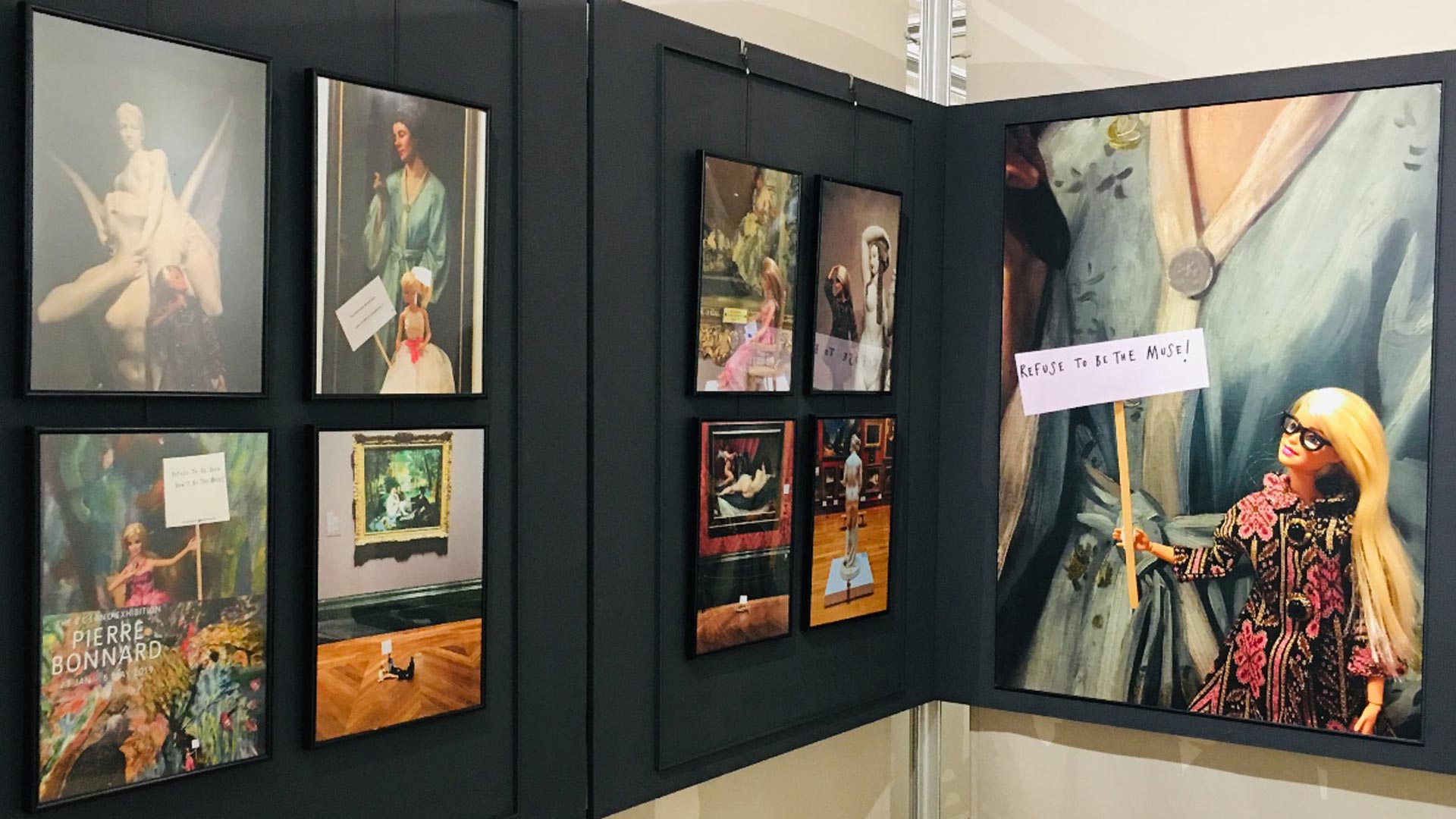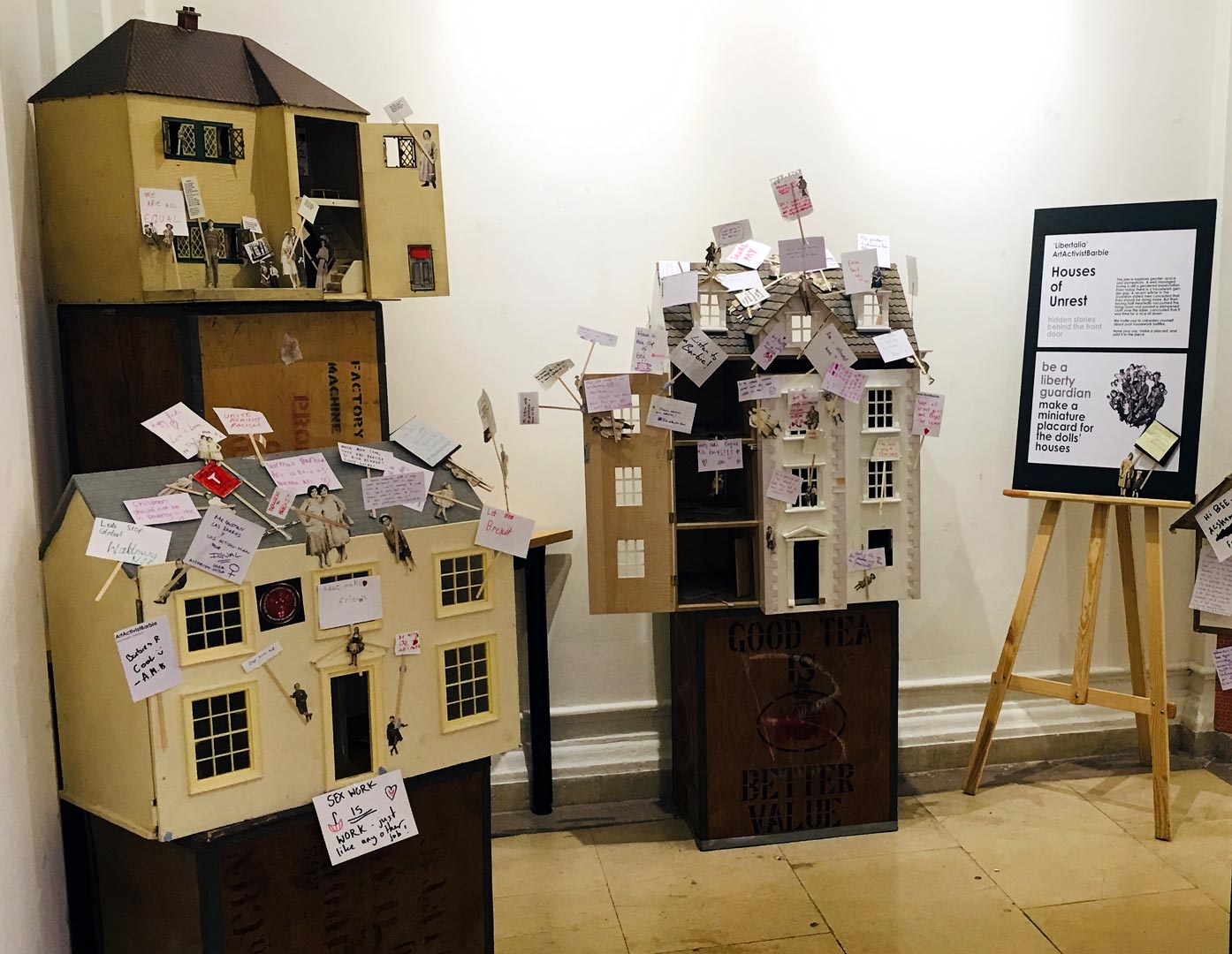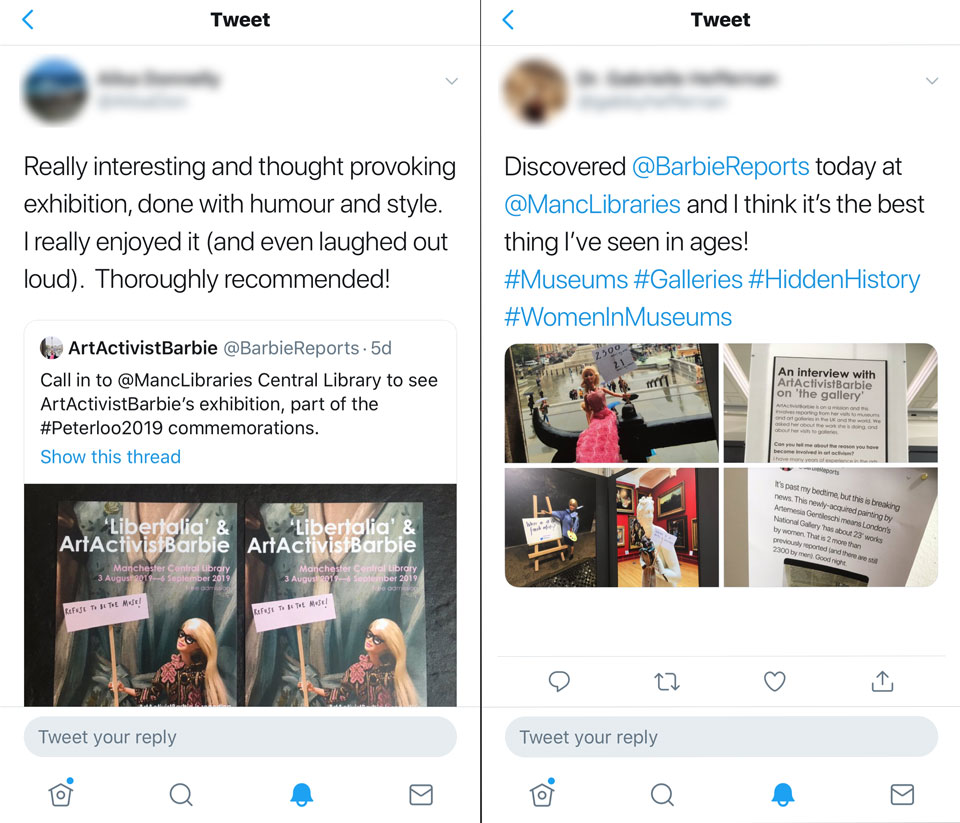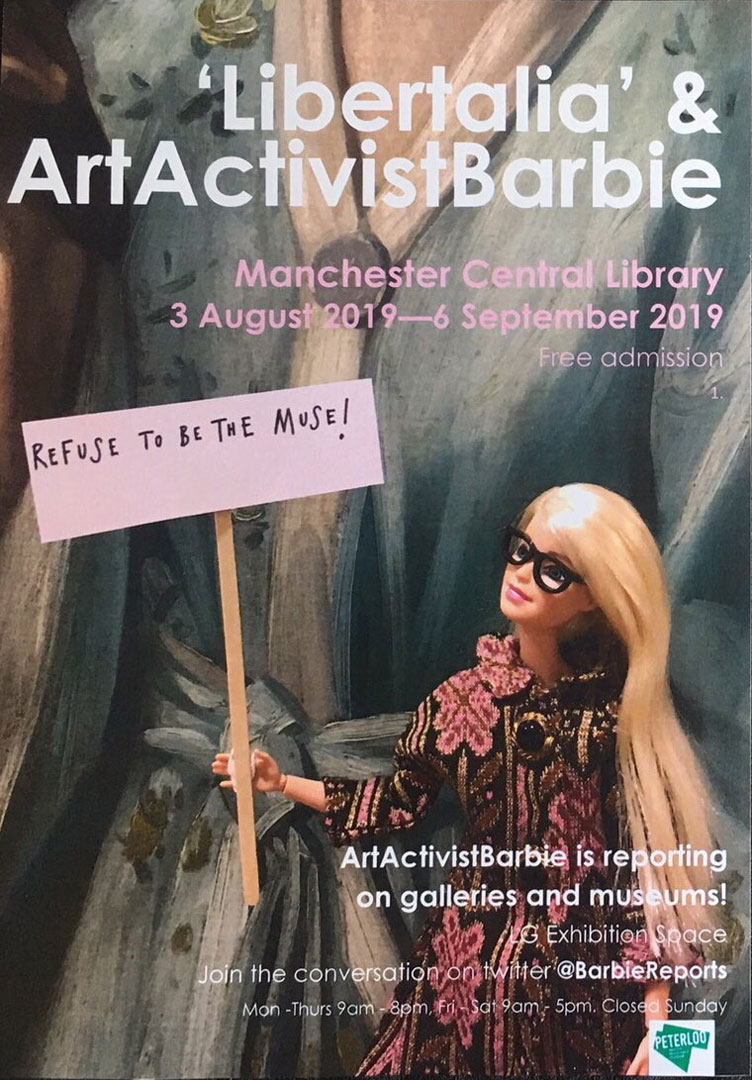
Sarah Williamson
HudCRES
During the summer of 2019, as part of an international research collaboration with the University of Victoria in Canada, Sarah Williamson and creative artist Alexis Johnson curated the exhibition LIBERTALIA & ‘LIBERTY GUARDIAN’ ARTACTIVISTBARBIE at Manchester Central Library. The exhibition ran from 3rd August to 5th September and was hugely successful, seeing great engagement from visitors and members of the public.
LIBERTALIA & ‘LIBERTY GUARDIAN’ ARTACTIVISTBARBIE, showcased the creative and disruptive force of feminist activist ‘ArtActivistBarbie’, creation of HudCRES academic and researcher Sarah. The exhibition was part of activities and events commemorating the 200th anniversary of the Peterloo Massacre in Manchester (Peterloo 2019 Events, Creative reflections of the legacy of Peterloo). Linking to the anniversary themes of protest, democracy and freedom and inspired by the change sought by those at Peterloo, the exhibition invited conversation and action on gender injustice and inequality.
ArtActivistbarbie (AAB)
The ongoing ArtActivistBarbie (AAB) project is an ‘a/r/tographic’ enquiry, where the three roles of a(artist), r(researcher) and t(teacher) co-exist and combine as a “research methodology, a creative practice, and a performative pedagogy” (Irwin, 2012, p.198). Responding to feminist researcher Olesen’s exhortation to “take our work public” (Olesen, 2017, p.163) , Barbie dolls are staged and posed in art galleries and museums using an aesthetic and playful pedagogic approach to draw attention to gender representation, inequality and injustice.
The potential to turn passive museum, gallery and exhibition spaces into transformational arenas which can educate for social justice is part of Sarah’s continuing art activism and research.
ArtActivistBarbie has been widely featured in the press and across social media, for example: by The Guardian 'That's not art it's Victorian porn!' - how one small Barbie doll took on the art world; BBC Culture The fine line between art and pornography; and renowned US feminist publication Ms Magazine We Heart: ArtActivistBarbie Taking on Patriarchy in the Art World.
Artists can encourage and facilitate engagement in public spaces and their ‘structures of power’, provoking political dialogue and social change (Ashton, 2018). This is important, because although things have improved, Pollock’s question in 2007, asking which cultural organisation or corporation would embrace or “sponsor a feminist intervention which challenges the assumptions of class, race and gender that underpin the current social system” (Pollock, 2007, p.10), remains unanswered.
The AAB project contributes to the call of Manicom and Walters for feminist adult educators to explore inventive pedagogical practices which have the potential to open up new possibilities for engagement: “pedagogies of possibility” (Manicom and Walters, 2012, p.2).

The main part of the exhibition displayed photographs of ArtActivistBarbie ‘in action’: intervening, commenting, protesting and disrupting. Biesta believes critical interruptions through art can “prepare the terrain for political action” (Biesta, 2012, p.694).
'Houses of Unrest'
ArtActivistBarbie’s ‘Houses of Unrest’ was an installation of vintage dolls houses as part of the exhibition. Visitors were invited to be ‘liberty guardians’ by making miniature placards to stage their own mini-protest. More than 120 mini-placards with slogans and comments were made and positioned on the ‘Houses of Unrest’. It was so popular that when the prepared cards ran out, visitors even made their own with scraps of paper and anything found to hand!
There were 38 placard statements specifically about women, equal rights, feminism, gender and trans rights.
‘We are all the same inside it doesn’t matter. Everyone is equal. We should be treated the same (Ava age 8)'
Another 36 placards had political messages or slogans on, eg. ‘End Child Poverty’ and ‘Unite against racism’

Many placards on the dolls houses were political commentaries and messages about a tense and escalating political situation as the exhibition coincided with the UK government’s ‘Brexit’ plans and heightened negotiations in the summer of 2019 to exit the European Union. The placards revealed agitation, anger and despair with the UK government; they revealed ‘unrest’.
It was apparent that the participatory aspect of the exhibition had allowed visitor agency in a public space (a public library) and a forum for voice.

Engaging, inspiring, stimulating and accessible
During this exhibition a range of feedback options were available and there were around 63 feedback cards filled in. There were many short, positive comments about how engaging, inspiring, stimulating and accessible the exhibition was:
‘Fantastic exhibition to stumble upon! As a young woman and also a feminist and an artist this exhibition was inspiring’
‘I love it! Really grabs your attention and talks about problems and situations that need to be heard. This will also attract the attention of children and hopefully motivate them to help change the world. Will definitely be following along’

The Barbie factor
Barbie has been “a loved and troubling presence since her debut” (Orr Vered and Maizonniaux, 2017, p.198), and Sarah has written elsewhere about how she uses Barbie subversively to captures people’s attention. The character of ‘ArtActivistBarbie’ (AAB) explores the subversive potential of Barbie’s popularity and iconic status to promote social and gender justice.
Feedback directly commented on how subversive or ironic the use of Barbie was:
‘A playful thing (toy) that is perceived as a symbol for women-as-a-pretty-thing asking serious questions. A subversive Barbie. The supposed innocence of Barbie attracts attention to the issue of representation’
‘Using a traditional figure of female repression by making a point using humour’
‘Extremely simple effective way of challenging curation and patriarchy’
‘Using a controversial figure like Barbie in an irreverent way. It's accessible to young people and children too’

Impact on knowledge, awareness, attitudes
Some comments reflected more of the impact on the audience’s thinking, with details of how the exhibition had challenged them, given them a different perspective or how they had learned something new about art and gender representation.
Absolutely shocked and staggered by the stat of 2300 works by men and 21 by women in OUR NATIONAL GALLERY! Appalling. We love the idea and irony of using a Barbie to highlight gender inequality - makes the idea accessible. This will change the way we look at galleries forever. Feminism = equality for all.
This exhibition was amazing and really highlights injustices in art, some I wasn't even aware of or didn't register (i.e. only 21/2300 paintings are by women, female artists are often referred to as 'wife/daughter of'). Last night I was reading through a How to Draw Portraits book and it outraged me that all the male examples were old with wrinkly, interesting faces whereas the female models were all topless, seductively posing and young. Not one undressed or seductive male pose, or a woman above 35. I go to all-girls school packed with feminists and am sending them photos of your work to them I know they'll love as well as suggesting your account. Thank you so much for this amazing work. PS: I love the subversive use of Barbie
Art is mostly by the male gaze for the male gaze. Women are not posed as heroic but demure or naked. We need more women artists represented and more active female and diverse subjects. Women are subjects not objects! Agency now!
Very interesting exhibition. Certainly made me think. Was stunned at the disparity between male and female works in the national gallery. Also sets you thinking how much art is out there that doesn't fit the norm expected even from old/Victorian times
I don't know much about the art world but this display got me thinking about representation in art back home in the US. Thank you!
It is clear that the exhibition showcasing the critical and feminist use of Barbie fostered the development of increased critical consciousness, and what Lowry has termed the ‘sociological eye’ (Lowry, 2016), in members of the public. It demonstrated the potential for exhibitions to be sites of agency, embodied enquiry, education, resistance and voice.
Barbie as feminist activist and pedagogue
You can read more about the deployment of Barbie as a feminist activist in museums and galleries in an article written by Sarah for The Conversation: Meet ArtActivistBarbie, the fearless funny feminist taking on a white male art world.
In a recently published book, Feminist Critique and the Museum: Educating for a Critical Consciousness, Sarah discusses ArtActivistBarbie as a critical public pedagogue and public intellectual, and as a feminist cyber-activist and feminist ventriloquist: The a/r/tographic re-deployment of Barbie in museums and galleries as a feminist activist and pedagogue.
Sarah is currently writing a book chapter about her research into the impact and potential of critical exhibitory practice, due to be published in 2021.
Follow ArtActivistBarbie @BarbieReports on Twitter
Story by Sarah Williamson and Kathrine Jensen, HudCRES.

